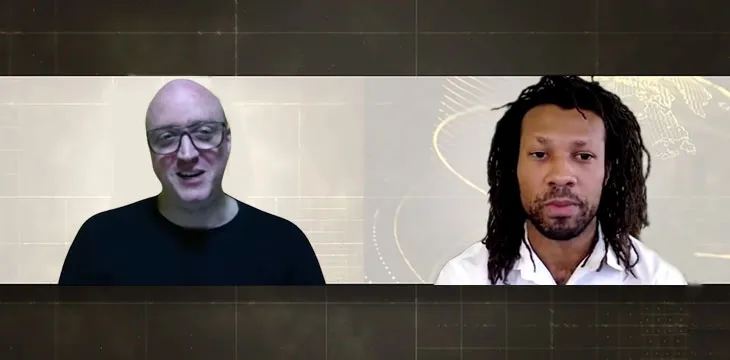|
Getting your Trinity Audio player ready...
|
https://www.youtube.com/watch?v=NlPGmoDaIj0
Richard Boase from Satoshi Block Dojo joined More Than Money to talk to CoinGeek’s Patrick Thompson about BSV and startup incubator Satoshi Block Dojo.
Check out the full interview on CoinGeek’s YouTube channel or read the summary of the discussion below.
Introducing Richard Boase and Satoshi Block Dojo
Richard Boase is a co-founder of Satoshi Block Dojo with his partner Craig Massey. He’s been a Bitcoin advocate for many years and has been involved in Bitcoin SV for a number of years.
Thompson inquires at what stage entrepreneurs should apply for funding to open up the interview. “Super early stages,” Boase replies. “The idea is to create as many opportunities and onramps onto BSV as possible.”
How is Satoshi Block Dojo different from traditional venture capital?
Thompson then asks how Satoshi Block Dojo is different from going down the traditional venture capital route.
Boase outlines that Satoshi Block Dojo initially offered £10,000 ($13,422) cash and a 12-week training program. They also give a lot of technological support. In return, they ask for 10% of the company.
At the end of the 12 weeks, the companies raised £140,000 ($188,000) through investors and investor leads provided by Satoshi Block Dojo. This will cost the entrepreneur approximately another 8% of the company.
“We introduce them to investors and help them through that initial fundraising,” Boase elaborates.
This £140,000 ($188,000) is raised through Seed Enterprise Investment Scheme (SEIS), which allows investors who put in up to £140,000 ($188,000) to claim 50% back from the U.K. government. If the company subsequently fails, they can claim a further 25% of their initial investment back. This makes it extremely attractive for investors.
After a year, Satoshi Block Dojo helps them raise another £1.4 million ($1.88 million). This is done through a U.K. government scheme called Enterprise Investment Scheme (EIS).
Satoshi Block Dojo’s cohort model
Thompson then asks Boase to explain more about Satoshi Block Dojo’s model whereby people apply and get accepted into cohorts.
“There are three cohorts a year, and each cohort is 12 weeks of training,” Boase explains.
He then outlines how they accept applications through their website and pitch the idea of building on BSV at universities. They then bring people in and train them, eventually selecting the best ideas and most promising entrepreneurs.
“If you’ve got a really clear idea, it’s really nicely presented, and we know what it is that you want to do, we’re quite likely to give you the green light and bring you in,” Boase says.
What makes it more (and less) likely to get into Satoshi Block Dojo?
Boase said that they quite often get ICO pitches. There’s no initial value proposition, but the entrepreneurs want to build with the funds they raise through the token offering. Boase says that this is a red flag but that they have green-lighted a few projects that have pitched this idea on the basis that they adopt Satoshi Block Dojo’s model instead.
“We want the opportunists who think they can build something that scales,” Boase says. “The only difference is we would like to be able to raise capital from traditional markets and for the companies to issue equity in the normal way.”
According to Boase, green flags are confidence, clarity, and honesty. “Those things go off so well and are so important to us.”
Boase says that one of the things Satoshi Block Dojo is keen on is getting young people from universities to experiment with ideas. This means they have to be hand-holders who know the ropes and be able to tell them what not to do.
“It’s a difficult balance,” Boase tells Thompson, speaking about the need to foster excitement and enthusiasm while encouraging real-world problem-solving.
On the companies accepted into the first Satoshi Block Dojo cohort
Thompson asks Boase to tell him more about the first companies accepted by Satoshi Block Dojo. What was unique about them? What made them special, and how are they using the blockchain?
Boase mentions a few of them, including:
- A communications app
- A remittance project
- An adult industry team
- A carbon trading application
- A metaverse project
- A fine art project
- A music project
“We’ve had a few who slipped through our fingers,” Boase reflects, thinking about those they have lost. He says that they’re most excited about the music project.
On the countries that Satoshi Block Dojo wants to have a presence in
Thompson notes that he has previously heard Satoshi Block Dojo co-founder Craig Massey talk about specific countries they want to have a presence in before moving into the Western world. He asks Boase to explain that line of reasoning.
Boase mentions Dubai, Pakistan, Poland, and Germany as countries of interest. Reasons include that Dr. Craig Wright doesn’t have so many negative connotations outside of the West that some had found it easier to open BSV incubators in the East. There is an enormous potential for expansion in places like Pakistan and Africa, where there’s both demand for remittances and a lot of thirst for the type of products BSV can bring to the market at scale.
Essentially, it’s an expansion strategy, but Boase admits it would be wonderful to have Satoshi Block Dojos in the USA. He hopes to see BSV workshops worldwide.
Why BSV versus the many other blockchains?
Thompson asks Boase the million-dollar question—Why BSV? He notes that there are so many other blockchains and wants to know why Satoshi Block Dojo focuses on BSV exclusively.
Boase explains that he’s a very dedicated student of Dr. Craig Wright. This leads him to view things through a specific lens influenced by his arguments. He’s thought about the efficiency, scaling potential, and much more and has concluded that BSV is the best bet.
“Cardano is a good example. It’s gone up 10x in value, and its transaction fees have, too,” Boase notes. “The minimum transaction fee on Cardano is £0.35, which means that as it gets successful, it prices itself out of the market. In BSV, the nodes scale vertically, so the bigger the block, the smaller the fee. Consequently, it just gets more and more competitive over time.”
“There’s no real competition, to be honest,” Boase adds.
What needs to take place for you and the team at Satoshi Block Dojo to consider the mission a success?
Boase explains that the way the Satoshi Block Dojo makes money is by selling companies. Therefore, the products that the Satoshi Block Dojo creates are companies or successful business models. This means that the more businesses they sell, the more successful they are.
Boase says that the majority of businesses that come through the Satoshi Block Dojo might sell for around £4 million ($5.37 million). However, he believes that the ultimate mark of success is having a unicorn and selling a billion-dollar business. “The higher valuations that we can sell the businesses at, the better.”
On a personal level, as a BSV holder, Boase says he will be happy if the asset price goes up. He wants to create businesses that drive the adoption of BSV.
Thompson ends the interview by agreeing that a higher BSV token price would be good. He thinks a higher price acts as a marketing tool that attracts users into the ecosystem and subsequently to all the applications within it.
Watch: Satoshi Block Dojo opens doors to next generation of BSV entrepreneurs
https://www.youtube.com/watch?v=6WxIPr4OT1Q

 07-03-2025
07-03-2025 





